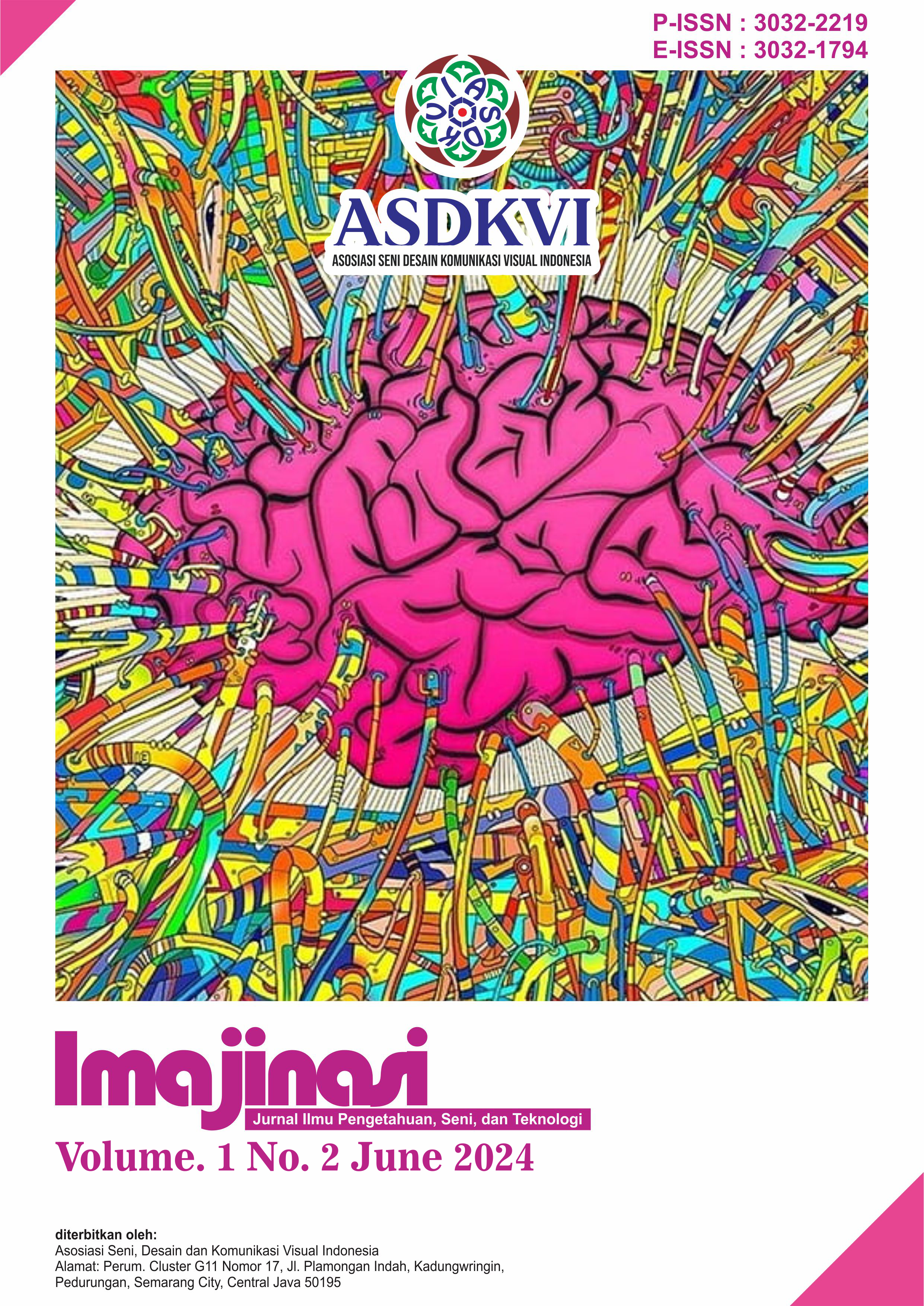Pengembangan Alat Peraga Biologi Berbasis Instgarm Terintegrasi Nilai- Nilai Keislaman Pada Materi Sistem Peredaraan Darah Manusia Kelas XI
DOI:
https://doi.org/10.62383/imajinasi.v1i2.153Keywords:
Learning Media, Biology Teaching Aids, Human Circulatory System, Integration of Islamic ValueAbstract
This research uses Research and Development (RnD) research, with a 4D development model. This research aims to find out how the product is developed and the level of feasibility through media, material and Islamic validation as well as the practicality of teachers and students. Data collection techniques for product development are through observation, interviews, questionnaires and documentation. Next, the data obtained was analyzed using quantitative descriptive analysis. This research produces a product in the form of an Instagram-based biology teaching aid integrated with Islamic values in the human circulatory system material. This product meets the valid and practical criteria by obtaining a validity assessment of 88.84% in the "very valid" category, validation results by material expert lecturers, obtaining a validity assessment of 88.2% in the "very valid" category and validation results by expert lecturers Islamic, a validity assessment of 88.83% was obtained in the "very valid" category. Meanwhile, practicality was determined by the biology teacher and class XI MA students. Based on the practicality results by biology teachers, a practicality assessment of 88.05% was obtained in the "very practical" category and practicality results by class XI high school students, a practicality assessment of 84.4% was obtained in the "very practical" category. Thus, Instagram-based biology teaching aids integrated with Islamic values are suitable for use as interactive learning media to test effectiveness at the next stage.
References
Abdillah, A. R. (2022). Pengembangan media pembelajaran booklet terintegrasi nilai Islam pada materi pencemaran lingkungan di SMA Unggulan Nurul Islami Semarang. UIN Walisongo.
Abdollah, A., Marwah, A. S., Wally, P., & Sohilauw, I. S. (2022). Uji kepraktisan pengembangan alat peraga untuk siswa SMA pada konsep sistem respirasi. Jurnal Biologi dan Pendidikan Biologi, 3(1), 1–12.
Anwas, O. M. (2014). Peran teknologi informasi dan komunikasi dalam implementasi kurikulum 2013. Jurnal Teknodik, 493–504. https://doi.org/10.32550/teknodik.v0i0.62
Ardhi, S. (2022). Pengembangan alat peraga sistem peredaran darah manusia dari barang bekas pada pembelajaran IPA siswa sekolah dasar. Empiricism Journal, 3(2), 399–405. https://doi.org/10.36312/ej.v3i2.1167
Arikunto, S. (2013). Prosedur penelitian suatu pendekatan praktik (Edisi Revisi). Jakarta: PT Rineka Cipta.
Ariyanto, A., Priyayi, D. F., & Dewi, L. (2018). Penggunaan media pembelajaran biologi di sekolah menengah atas (SMA) swasta Salatiga. BIOEDUKASI (Jurnal Pendidikan Biologi), 9(1), 1. https://doi.org/10.24127/bioedukasi.v9i1.1377
Fitri, A., Efriyanti, L., & Silmi, R. (2023). Pengembangan modul ajar digital informatika jaringan komputer dan internet menggunakan Canva di SMAN 1 Harau. JATI (Jurnal Mahasiswa Teknik Informatika), 7(1), 33–38. https://doi.org/10.36040/jati.v7i1.5999
Khairaty, N. I., Taiyeb, A. M., & Hartati, H. (2018). Identifikasi miskonsepsi siswa pada materi sistem peredaran darah dengan menggunakan three-tier test di kelas XI IPA 1 SMA Negeri 1 Bontonompo. Jurnal Nalar Pendidikan, 6(1), 7. https://doi.org/10.26858/jnp.v6i1.6037
Kusnandi, C., & Sujipto, B. (2013). Media pembelajaran manual dan digital. Jakarta: Ghlia Indonesia.
Lawhon, D. (1976). Instructional development for training teachers of exceptional children: A sourcebook. Journal of School Psychology, 14(1), 75. https://doi.org/10.1016/0022-4405(76)90066-2
Mardhiah, A., & Akbar, S. A. (2018). Efektivitas media pembelajaran terhadap hasil belajar kimia siswa SMA Negeri 16 Banda Aceh. Lantanida Journal, 6(1), 49. https://doi.org/10.22373/lj.v6i1.3173
Maulansyah, R. D., Febrianty, D., & Asbari, M. (2023). Peran guru dalam peningkatan mutu pendidikan: Penting dan genting! 2(5), 31–35.
Napitupulu, E. L. (2023). Narasi skor PISA Indonesia jangan seolah-olah prestasi. https://www.kompas.id/baca/humaniora/2023/12/06/narasi-skor-pisa-indonesia-jangan-seolah-olah-prestasi
Olip, R. (2023). Wawancara 1.
Özgür, S. (2013). The persistence of misconceptions about the human blood circulatory system among students in different grade levels. International Journal of Environmental and Science Education, 8(2), 255–268. https://doi.org/10.12973/ijese.2013.206a
Rahmi, R., Putra, I., Naa, A., & Maulidia, A. F. (2023). Pemanfaatan media sosial Instagram dalam personal branding pada akun @belinda.firdaa, 1031–1039.
Resmini, S., Satriani, I., & Rafi, D. M. (2021). Pelatihan penggunaan aplikasi Canva sebagai media pembuatan bahan ajar dalam pembelajaran bahasa Inggris. Abdimas Siliwangi, 4(2), 335–343. http://dx.doi.org/10.22460/as.v4i2p%25p.6859
Riduwan. (2015). Skala pengukuran variabel-variabel penelitian. Bandung: Alfabeta.
Riyanto, A. D. (2023). Hootsuite (We Are Social): Indonesian digital report 2023. https://andi.link/hootsuite-we-are-social-indonesian-digital-report-2023/
Rizkinaswara, L. (2023). Menkominfo: Kominfo putus akses 1,9 juta konten pornografi. https://aptika.kominfo.go.id/2023/09/menteri-budi-arie-kominfo-putus-akses-19-juta-konten-pornografi/
Sadya, S. (2023). Twitter jadi medsos sarang konten negatif hingga awal Maret 2023. https://dataindonesia.id/internet/detail/twitter-jadi-medsos-sarang-konten-negatif-hingga-awal-maret-2023
Sihaloho, M. J. (2017). Ini konten negatif yang dominan di Indonesia. https://www.beritasatu.com/news/465882/ini-konten-negatif-yang-dominan-di-indonesia
Downloads
Published
How to Cite
Issue
Section
License
Copyright (c) 2024 Imajinasi : Jurnal Ilmu Pengetahuan, Seni, dan Teknologi

This work is licensed under a Creative Commons Attribution-ShareAlike 4.0 International License.





